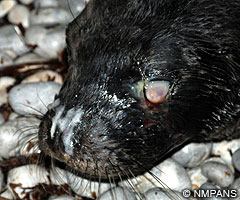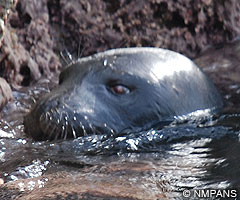The in situ treatment of a Mediterranean monk seal pup at Piperi Island, National Marine Park of Alonnisos Northern Sporades (NMPANS)
Christos Neofitou1, Lenie ‘t Hart2, Vassilis Kouroutos3, Kitty Attema4,
Elefteria Tsalie5 and Clare Reed6
The NMPANS has witnessed the successful birth of six Mediterranean monk seal pups in the shelters around the reserve since September this year, all of which seem to be well nursed by their mothers.
Two of the seal pups, together with their mothers, were observed in the same cave on the southeast coast of the island of Skopelos. Currently, the NMPANS does not incorporate the S.E. coast of Skopelos in its protection area, despite the fact that this island is included in the Natura 2000 Network and is well-known for its important monk seal shelters. It is expected that this area will become part of the Marine Park in the summer of 2009 when the Management Plan of the NMPANS is approved.
The other four pups were observed in shelters on the island of Piperi, the core zone of the Park, together with their mothers. A placenta and hair samples from four seal pups were collected for genetic analysis.
It is also important to note that the birth of these seals occurred 10 days (20 September) earlier this year than in 2007.
Three out of these four pups, observed in the same shelter at Piperi, seemed to be in excellent condition, while the fourth had a serious ocular condition. An in situ assessment of the eye and the pup’s general health condition was made by a team consisting of the Marine Park’s veterinarian, a biologist from MOm’s Monk Seal Rescue and Rehabilitation Centre, and Park personnel on 18 October. It was established that the left eye was infected, but also that the pup was still being nursed by its mother. An attempt to provide on site treatment to the pup proved unsuccessful due to the presence of the other three pups in the shelter, which were alert to the team’s presence. Photographs taken of the infected eye were sent to the Seal Rehabilitation and Research Centre Lenie ‘t Hart (SRRC), Pieterburen, for consultation with the SRRC’s eye-expert, veterinarian, and Lenie ‘t Hart. They advised the NMPANS to treat the animal on site, if possible, and thus attempt to conserve the bond between mother and pup.
The use of a long-acting antibiotic (Cevofecin) was recommended by the SRRC’s veterinarian, since the SRRC have experienced some good results using this treatment. The antibiotic makes it possible to keep seal handling to a minimum; its antimicrobial effects last for 14 days.
On 18 October, a certified assistant vet from the SRRC was invited by the President of the National Marine Park of Alonnisos Northern Sporades. She arrived the following day.
A team set out for Piperi on the 20 October. Upon arrival at the cave, only two pups (from the four previously observed in the shelter) were present, both in good physical condition. One of the pups, born the previous week, was sleeping halfway up in the cave, while the other slept with its back towards the entrance and hind flippers touching the water. It was this individual that proved to be the half-blinded pup.
The experienced seal nurse (assistant vet) was able to catch and restrain the animal. The mucous membranes of the mouth had a healthy pink colour, and the pup proved to be very strong. After administering the antibiotic subcutaneously, the nurse took a bacterial and viral swab of the left eye for further analysis.
After the pup was released it sought safety in the water. This was a good way to assess whether it had any other underlying (physical/neurological) problems; from watching it swim, it was concluded that this was not the case. It swam for about 50 metres along the rock face before hauling out on a ledge, which proved it was a good swimmer for such a young pup. It did not seem overly affected by the ordeal.
It is now imperative that the mother continues nursing the pup in order to encourage the healing process of the eye. There will be a follow-up to check on the condition of the pup’s eye after the antibiotic has had time to show its effects.
The Progression of the Eye Infection

enlarge
|
15 October: The cornea appears white/yellow. Some purulent discharge from both nostrils. A red (inflamed) third eyelid. From this picture it is hard to establish what the actual problem might be. It could be a symptom of a more serious underlying problem, but could also be a straightforward eye infection.
|
|

enlarge
|
17 October: Significant amount of purulent discharge from both nostrils. The left eye is oozing pus and bloody fluid. The infection itself is most probably a combination of a nasopharyngeal and ocular infection. It should heal over time with the antibiotics administered. The eye has spontaneously ruptured. After the infection has cleared the eye will probably atrophy. In some cases at the SRRC however, recovery of the eye has been observed, but it is hard to predict what will happen.
|
|

enlarge
|
20 October: The globe of the infected eye is smaller than the normal right eye. The reddish colour of the vascular infiltration is a sign that the healing process is already starting. The bluish tinge in the rest of the eye is oedema of the cornea, which is a normal occurrence with eye problems/infections. If the infectious debris (pus) were properly drained and new build-up prevented by the antibiotic, then the eye could improve. Depending on the severity and underlying cause of the initial infection and physical condition of the pup, it could take several days to weeks until the eye is properly healed; this is hard to estimate.
|
|
(1) Professor Christos Neofitou is President of the Management Body of the NMPANS
(2) Lenie ‘t Hart is founder and director of the Seal Rehabilitation and Research Centre (SRRC) Lenie ‘t Hart, Pieterburen, The Netherlands
(3) Vassilis Kouroutos is a Marine Biologist and Monk Seal expert of the NMPANS
(4) Kitty Attema is Senior Seal Nurse at the SRRC Lenie ‘t Hart, Pieterburen, The Netherlands
(5) Elefteria Tsalie is veterinary advisor to the NMPANS
(6) Clare Reed, a Marine Biologist, is currently a volunteer at NMPANS
|






